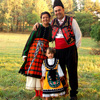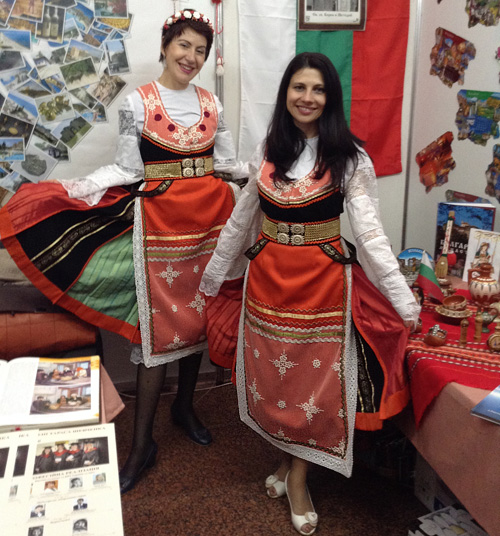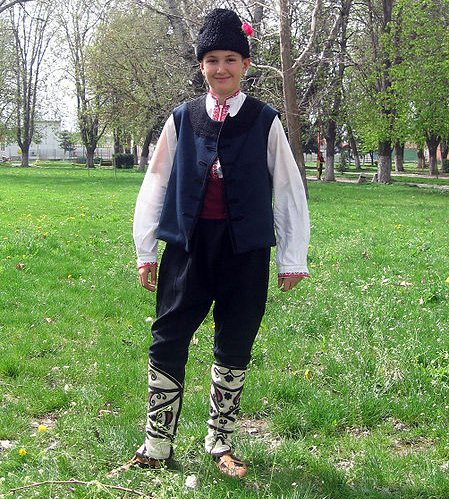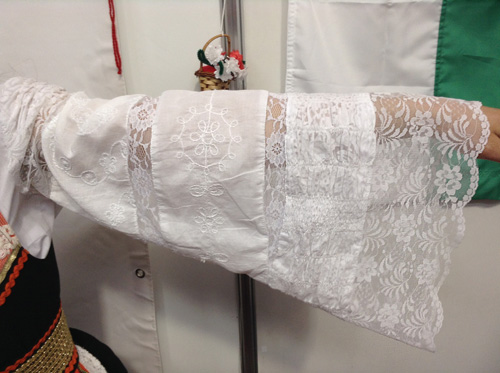
Bulgaria is an interesting Balkan country. Historically Bulgarians are ancestors of Turkic tribes called Bulgars, which mixed with a majority of Slavonic tribes in the area, inheriting it from the Thracians. The country is located at a crossroads between Europe, Asia and North Africa, which is why it has features of different cultures, along with the distinctive Slavic world. The country has an ethnically diverse population so there are groups with more Islamic and Turkish influence, such as the Muslim Bulgarians. We can say the same about the traditional costumes of Bulgaria and its clothing traditions. Today, the folk outfit of Bulgaria is a mix of ancient and modern pieces of clothing, with garments that reflect the peoples that brought them to the area. And this mix of diverse cultures and tastes is awesome!
The characteristics and peculiarities of the traditional Bulgarian attire depend on many factors: region, marital status, occupation, class, etc. You can observe dramatically different folk costumes in different regions of the country or even different villages. But in general, Bulgarian national male costumes are divided into 2 types: so-called "black dress" ("chernodresnik") and "white dress" ("belodresnik"). Women's traditional outfits are divided into 3 types: costumes based on double apron, on tunic (called "soukman"), and on open-fronted coat or dress (called "saya").

Women in traditional Bulgarian outfits typical for the eastern part of the country. The costumes are based on a double apron. These particular garments are used by folk dancers
One of many curious things about Bulgarian folk dress is that the most embellished, bright, and ornate women's costumes were traditionally used by the youth. Brides wore the most beautiful and rich costumes ever. And after a girl got married, she gave up wearing colorful and richly decorated garments and chose modest outfits instead. She also started to wear a headscarf. Married older women and widows used clothing with much fewer decorations than young girls did. By the way, men used the same folk costume, no matter what their age was. It didn't change because of the marital status.
Men's traditional outfit
As we've mentioned earlier, Bulgarian men use either chernodresnik (dark clothing), or belodresnik (white clothing). These two types of costumes were formed by the opposite cultures: the Ottoman fashion and the European Slavic fashion. Belodresnik has much more ancient origins; it is worn in the northern, western, and southwestern parts of Bulgaria which are closer to Europe and its influence. Chernodresnik is worn in the central, eastern, and northeastern parts of the country which are closer to Turkey and the Ottoman influence. Some regions of Bulgaria use a mix of these two styles. For example, in Sofia (the capital of Bulgaria) men wear a dark top and a white bottom.
The traditional male clothing of this country is usually made from linen, hemp, wool, and cotton. All of that used to be homespun, but today they're mostly manufactured industrially.
Belodresnik type of costume
One of the main items is a shirt. Men's shirt is made from linen or hemp; it is often collarless. The length of the shirt for belodresnik is either to the knee or to the calf. The shirt is worn over trousers and is always belted. In some regions Bulgarian males wear shirts with a very wide bottom, similar to the Greek foustanella. Such garment was brought to Bulgaria during the Ottoman period, just like it was to Greece. The men's traditional shirt in Bulgaria has some embroidery as embellishment, but not much. Usually, the neck opening and the cuffs are embroidered with geometric patterns.
There are two types of traditional trousers: summer and winter trousers. Summer trousers are linen or cotton. They are wide and short (just below the knee). Winter trousers are woolen, long and tight-fitting.
The men's garment always includes a belt. Belodresnik is usually complemented with a wide woven woolen belt. A narrow leather belt sometimes is used on top of the wide fabric waistband.

Traditional Bulgarian belodresnik. Photographer: Vassia Atanassova. Photo from Wikimedia.org
There are several types of outerwear used by men in Bulgaria. One of them is a hooded shepherd's cloak made from wool, goat's hair or a mix of them. This garment is very ancient. It can be either festive or for an everyday usage. Festive cloaks were decorated with embroidery, braiding, and ribbons. Another variant of an outerwear that is a part of a "white dress" is a coat made from felted white woolen cloth. The cut is usually a little bit flared. There are different variations of this garment: with long and short sleeves, sleeveless, calf-, thigh-, or waist-length. It also can be either simple for a day-to-day usage or embellished and festive for special occasions.
The headdress of Bulgarian males is called "kalpak". It is a sheepskin hat of various shapes. In some areas, it is worn over a red skullcap made from natural fabrics.
Bulgarian traditional shoes are usually made of leather. Simple peasant sandals are called "tservuli". They are made from pig or cow skin, tight-fitting, and tied to the foot by a cord. Tservuli are worn over woolen socks or leg wraps. Similar traditional shoes are used by Ukrainians and are called "postoly" (several examples you can find here). Wealthy Bulgarians traditionally used leather boots.
Chernodresnik type of costume
The shirt for chernodresnik is more tight-fitting and shorter than for belodresnik. It is worn with a waistcoat or a jacket and tucked into trousers. The shirt has a collar and cuffed sleeves. There is very little or no embroidery to decorate this type of shirt.
The trousers are called "poturi" or "shalvari". They are dark and very wide, but the fabric is narrowing to the ankles. The upper part of shalvari is wide, and the bottom part is very tight-fitting. Historically, the wealthier a man was the wider shalvari he wore. The trousers are belted at the waist and can have some decorations to make them look more festive.
Chernodresnik usually has a wide woven woolen belt. Its color is red or red with white stripes, another variant is black-and-red checked pattern. A narrow leather belt often is used on top of the wide fabric waistband.

Traditional Bulgarian chernodresnik. Photographer: Pakko. Photo from Wikimedia.org
There are several types of outerwear used by men in Bulgaria. One of them is a hooded shepherd's cloak made from wool, goat's hair or a mix of them. This garment is very ancient. It can be either festive or for an everyday usage. Festive cloaks are decorated with embroidery, braiding, and ribbons. Another type of an outerwear that is a part of a "black dress" is a short dark woolen jacket. It has a round neck, two rows of buttons at the front, and can be long-sleeved or sleeveless.
The headdress of Bulgarian males is called "kalpak". It is a sheepskin hat of various shapes. In some areas, it is worn over a red skullcap made from natural fabrics.
Bulgarian traditional shoes are usually made of leather. Simple peasant sandals are called "tservuli". They are made from pig or cow skin, tight-fitting, and tied to the foot by a cord. Tservuli are worn over woolen socks or leg wraps. Similar traditional shoes are used by Ukrainians and called "postoly". Wealthy Bulgarians historically used leather boots.
Women's traditional outfit
If you remember, we've mentioned earlier that Bulgarian traditional women's attire is divided into 3 different types: costumes based on double apron, on tunic (called "soukman"), and on open-fronted coat or dress (called "saya"). But there is one common piece of clothing used with all three types – a chemise. It is an obligatory item. Sometimes it serves as a shirt and in other cases as an undergarment. Such chemises can be of different design accordingly to the usage. A chemise of the most common design is called "riza". It is a long shirt with long sleeves and a round neckline with a short slit at the front. It can be either a straight-cut shirt or a chemise with extra width and wide sleeves. Riza, especially the one worn with an apron, often is embroidered at the neckline and along the sleeves or has lace on the hem and sleeves. The chemise worn with saya and soukman is simpler, with fewer decorations, because only a little part of the shirt is visible. There is another variant of a chemise used by Bulgarian women. It is called "burchanka". This garment is worn mostly in the northern part of the country. Burchanka is used with a double apron. This chemise is wide, the fabric is gathered into the neckline. The sleeves are also wide, gathered at the cuffs. Burchanka usually is beautifully decorated with embroidery, smocking, and lace.

Beautifully embellished sleeve of a chemise worn with a double apron. It is decorated with embroidery and lacing
The double apron is a traditional piece of clothing that belongs to the Slavic cultural heritage. It is used in those regions of Bulgaria closer to Europe. This garment is similar to Ukrainian wrap-around skirt called "plakhta" (you can find some examples here), and woven skirts typical for the other countries in the Eastern Europe. This piece of a folk dress consists of two woven woolen aprons, one at the front and one at the back. It is worn over the chemise and covers a female body from the waist to below the knee. The bottom (embellished) part of the chemise is usually visible from under the apron. The front part of the double apron is narrow, and the back part can be either also narrow or wider. The back apron is called "bruchnik", and there are several designs of it. Bruchnik can have red & black vertical stripes; in this case, the front apron has similar horizontal stripes and is richly embellished. It can be made from dark woolen fabric adorned with black velvet; the front apron is also dark with horizontal colorful stripes. The third variant of a bruchnik is black, pleated or gathered at the waist, and decorated with embroidery, sequins, and similar embellishments; the front apron is wide, usually red, and with an ornate hem.
Saya is another variant of the main women's garment in Bulgaria. It is made from woolen, cotton, or linen fabric. Saya can be long or knee-length, with round neckline, and various lengths of sleeves. The sides of this garment are often slit. The color of saya can be different; usually, it is dyed in a single color or striped. Saya is worn over the chemise with a front apron on top of it. There are two main designs of a saya: a plain-colored knee- or calf-length dress with short sleeves and a long striped dress with long sleeves. The plain-colored (woolen, hempen or linen) saya is white, black, green or blue, worn with plain or colorful apron. It is richly embellished with embroidery and braiding. The striped saya is more modern. It is made from wool, cotton or silk, and has a lot of embellishments. The apron used with such saya is made from striped or checkered cloth, with no decorations. Saya was worn by Bulgarian women in day-to-day life until the middle of the 20th century.
The soukman is a tunic used by females in Bulgaria. It is made from black or dark blue felted woolen fabric, cotton, linen, or hemp. Usually, it is sleeveless or has short sleeves, sometimes long sleeves are also used. The neckline is round or V-shaped. Women often add gussets to the soukman for some extra width. The gussets can be added at the waist to form a wide skirt or below the arms to make the whole garment wider. In some regions, the soukman consists of separate parts: short, sleeveless bodice and a skirt. The skirt is gathered at the back and flat at the front. A front apron is worn with this design of a soukman. Regardless of design, soukman is always decorated with embroidery, braiding, or appliquéd strips.

Traditional female costume based on soukman. Photographer: Vassia Atanassova. Photo from Wikimedia.org
Bulgarian women always wear belt with the traditional costume. The belts are very beautiful and ornate. Mostly they are woven (Bulgarians keep their traditions and use an ancient technique of weaving belts), colorful, and often embellished with beads. Such belts are long and wrapped around the waist once or several times. The belt can also be short and fastened with an ornate buckle. The buckle is called "pafka".
Bulgarian traditional women's headdresses differ depending on the marital status. Unmarried girls wear their hair braided or use pretty headbands and ribbons. Married women wear cotton or silk headscarves. Sometimes they use a kind of bonnet beneath the scarf. The scarves are brightly colored, sometimes embellished with fringes and gold coins.

Bulgarian female wide belt with special loops. These loops are used by the folk dancers during the traditional Bulgarian dance
The overgarments of Bulgarian women are similar to male ones. They use hooded shepherd's cloaks and coats made from felted white woolen cloth as well. Women, who wear saya, use short woolen waistcoats. They have either long or short sleeves. The fabric is black, dark red or dark blue.
Bulgarian traditional female shoes are usually made of leather. Simple peasant sandals are called "tservuli". They are used by both men and women. They are made from pig or cow skin, tight-fitting, and tied to the foot by a cord. Tservuli are worn over woolen socks or leg wraps. Similar traditional shoes are used by Ukrainians and called "postoly" (several examples you can find here). Wealthy Bulgarians historically used leather boots.



Bulgarians are a mix of Old Bulgar tribes and (more numerous) Slavic tribes formed around 680AD. No Turks or Tatars here. The Bulgarian nation accepted Christianity around 850AD. It is still Christian. Bulgarian culture has no Islamic features. The Muslim Turks arrived from Asia and conquered Bulgaria in 1398AD. They occupied Bulgaria until 1878. THIS is why certain features of the traditional costume have Turkish origin.
sites regular. It'll always be provoking to read content from other writers and practice a little something from their
shop. I’d favor to use some with the content on my blog whether you do’t mind.
Natually I’ll give you a link on your own web site.
Thanks for sharing.